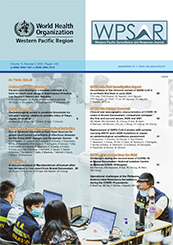Clinical and demographic characteristics of COVID-19 cases in Brunei Darussalam: comparison between the first and second waves, 2020 and 2021
DOI:
https://doi.org/10.5365/wpsar.2022.13.3.925Keywords:
SARS-CoV-2, COVID-19, demographics, signs and symptoms, retrospective study, BruneiAbstract
Objective: Differences in clinical manifestations between strains of severe acute respiratory syndrome coronavirus 2 (SARS-CoV-2) have been reported. This retrospective descriptive study compares the clinical and demographic characteristics of all confirmed coronavirus disease (COVID-19) cases admitted to the National Isolation Centre (NIC) in the first wave and at the beginning of the second wave of the pandemic in Brunei Darussalam.
Methods: All COVID-19 cases admitted to the NIC between 9 March and 6 May 2020 (first wave) and 7–17 August 2021 (second wave) were included. Data were obtained from NIC databases and case characteristics compared using Student’s t-tests and chi-squared tests, as appropriate.
Results: Cases from the first wave were significantly older than those from the second wave (mean 37.2 vs 29.7 years, P<0.001), and a higher proportion reported comorbidities (30.5% vs 20.3%, P=0.019). Cases from the second wave were more likely to be symptomatic at admission (77.7% vs 63.1%, P<0.001), with a higher proportion reporting cough, anosmia, sore throat and ageusia/dysgeusia; however, myalgia and nausea/vomiting were more common among symptomatic first wave cases (all P<0.05). There was no difference in the mean number of reported symptoms (2.6 vs 2.4, P=0.890).
Discussion: Our study showed clear differences in the profile of COVID-19 cases in Brunei Darussalam between the first and second waves, reflecting a shift in the predominating SARS-CoV-2 strain. Awareness of changes in COVID-19 disease manifestation can help guide adjustments to management policies such as duration of isolation, testing strategies, and criteria for admission and treatment.

